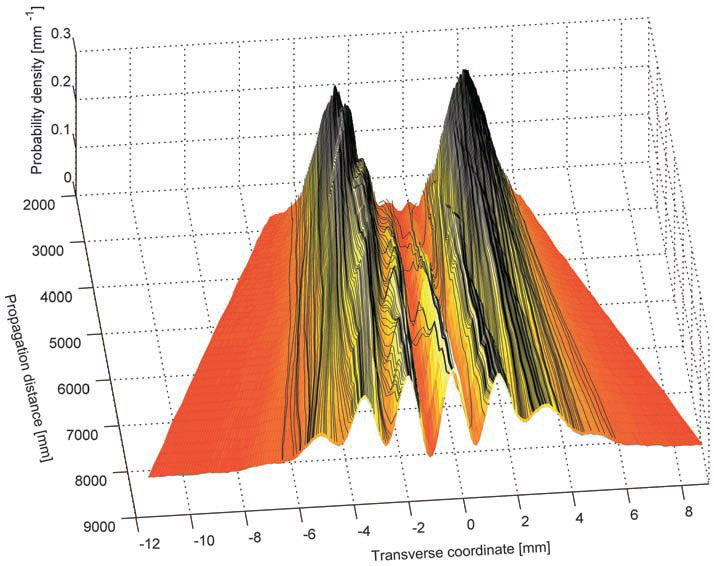
© Physics World3D plot of a single photon showing wave-like behaviour.
An international team of researchers has, for the first time, mapped complete trajectories of single photons in Young's famous double slit experiment. The finding takes an important first step towards measuring complimentary variables of a quantum system - which until now has been considered impossible as a consequence of the Heisenberg uncertainty principle.
In the double slit experiment, a beam of light is shone onto a screen through two slits, which results in an interference pattern on the screen. The paradox was that one could not tell which slit single photons had passed through, as measuring this would directly distort the interference pattern on the screen. "In most science, it is possible to look at what a system is doing presently and so, determine its past or future. But in quantum mechanics, it is considered inconceivable to consider the past at all." says physicist Aephraim Steinberg of the Centre for Quantum Information and Quantum Control at the University of Toronto, Canada who has led this new research.
Now, using a technique known as "weak measurement" Steinberg and his team say they have managed to accurately measure both position and momentum of single photons in a two-slit interferometer experiment. The work was inspired by one of Steinberg's colleagues, Howard Wiseman of Griffith University, Australia, who proposed in 2007 that it may be possible to use weak measurements to determine momenta and positions in the double slit experiment. Steinberg was immediately fascinated and began to see how this would become experimentally viable.
Catching a glimpseThe theory of "weak measurement" first proposed in 1988 and developed by physicist Yakir Aharonov and his group at Tel Aviv University, Israel, has seen a fair amount of interest in recent years. The theory states that it is possible to "weakly" measure a system and so gain some information about one property without appreciably disturbing the complimentary property and so the future evolution of the entire system. Though the information obtained for each measurement is minimal, an average of multiple measurements gives an accurate estimation of the measurement of the property without distorting its final outcome.
In their experiment, the researchers sent an ensemble of single photons through a two-slit interferometer and performed a weak measurement so as to imprecisely measure the momentum of each photon. This was done using a piece of quartz calcite, which serves as a polarizer. Depending on the direction of propagation each photon is differently polarized and the direction is measured as a function of position. This was then followed by an extremely accurate measurement of the final position of where each photon hits the "screen", which in their case, was a camera. By combining the positions measured imprecisely at multiple points and the momentum precisely measured at the end for each photon, they were able to accurately construct an entire flow pattern for the photons.
"This weak momentum measurement does not appreciably disturb the system, and interference is still observed. Both measurements had to be repeated on a large ensemble of particles in order to gain enough information for the whole system, but we did not disturb the outcome at all." explains Steinberg. "Our measured trajectories are consistent, as Wiseman had predicted, with the realistic but unconventional interpretation of quantum mechanics of such influential thinkers as David Bohm and Louis de Broglie,"
The single photons they used in the experiment were emitted by a liquid helium-cooled InGaAs quantum dot that is optically pumped by a laser, specially developed at the National Institute for Standards and Technology in Colorado, US. The dot then emitted single photons at a wavelength of 943 nm.
Past, present and futureThe double slit experiment heavily influenced the principle of complementarity devised by Niels Bohr. Complementarity states that observing complementary variables, such as the particle-like trajectories and the wave-like interference in the double-slit experiment, depends on the type of measurement made - the system cannot behave as both a particle and wave simultaneously. Steinberg's recent experiment suggests this doesn't have to be the case - the system can behave as both.
So would either Einstein or Bohr be pleased or surprised that this seemingly impossible measurement has been made? "Well, I don't think that Einstein would be surprised at all! But at the same time I do not think that this would make him more comfortable with the quantum mechanics of single systems" says Steinberg, explaining that Einstein was eager to accurately measure all the parameters of a single quantum system, something that we are not capable of just yet. "Bohr is a different matter... I doubt that his contemporaries even understood exactly what he was trying to say" says Steinberg. "But maybe this measurement would make him [Bohr] slightly more careful with his language while talking about complementarity."
The research is published in
Science.
Practical application?